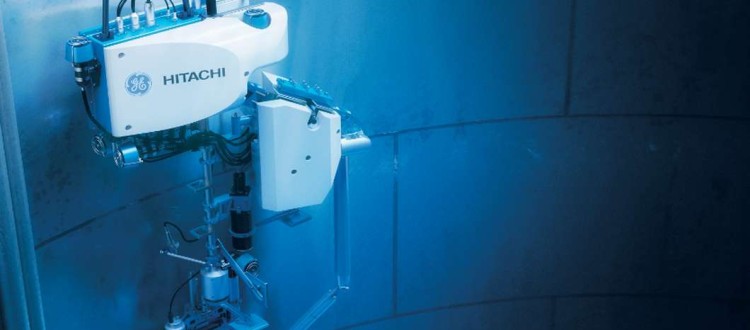Stinger The Swimming Robot Keeps Nuclear Reactors Healthy
Nothing says summertime in Georgia like a dip in the old swimming hole. But
near the town of Baxley, there’s one pool that’s not open to the public: the
crystal-clear blue waters of the containment vessel bathing the Edwin Irby
Hatch Power Plant’s nuclear reactors.
Although this is no place for a swim, the vessel must be monitored. In the
past, during scheduled maintenance and refueling downtimes, multiple
inspectors would clamber onto platforms that extended above the pool and
plunge into the vessel cameras mounted on poles or tied to ropes. Using
such handheld devices allowed them to get a close-up view of the welds in
the reactor pressure vessel and also surfaces that had to be kept in perfect
order. It worked, but it was a slow process and the inspectors had to protect
themselves from radiation from the fuel below.
But now the team has a new member that’s happy to jump in. He’s called
Stinger, the swimming robot, and allows nuclear plant personnel to go places
no human could reach before.
Stinger, which is a bit taller than an average human, is a steerable unmanned
underwater vehicle. He comes equipped with multidirectional, computer-
controlled thrusters and a high-resolution color video camera. “Where
Stinger’s camera and tools need to operate, a human could not survive in
that location,” says Brandon Smith, the GE Hitachi Nuclear Energy
mechanical engineer who led development of the machine. “That’s exactly
why we need robotics to do this kind of work. There’s just no other way to do
it and Stinger is built specifically to operate in that type of environment.”
The first-of-its-kind remote-operated vehicle is now being deployed to
nuclear power plants across the U.S. as they go through scheduled refueling
and inspection outages. It dives in the reactor pool for up to three weeks,
using cameras to get a good look at material degradation. In addition to its
camera technology, it also carries a high-pressure water nozzle, or
hydrolaser, to clean metallic surfaces to ensure a good, clean look at the
welds.
Smith and his team gave the robot a tungsten frock for protection and
electronics that are less susceptible to high radiation levels. A single
technician can operate it remotely from a tent hundreds of feet away from
the vessel. The robot is connected through a power and control umbilical to
the on-site operator and off-site, certified inspectors.
“The technician uses Stinger’s cameras to look for signs of degradation,”
says Smith. “It’s really good at getting into constricted spaces and around
tight corners to look for any sign that a component might fail—to catch
something before it becomes a problem.”
Stinger is now successfully performing inspections throughout the U.S.
nuclear industry. Smith says customers like it because it can work longer
with fewer concerns about radiation exposure. It can also perform its job
while other outage operations are going on since it doesn’t need inspectors
to be suspended above the reactor pool. These benefits translate to shorter
plant downtime and lower safety risks to employees.
“Our customers make money when their plants are producing power, so
they’re always trying to reduce the length of necessary downtime,” says
Smith. “They’re also always looking to reduce radiation exposure to workers.
By moving Stinger in and workers away to a lower dose area, they are able
to accomplish both goals.”
NDT.org
Image credits: GE Hitachi Nuclear Energy (nuclear reactors)

